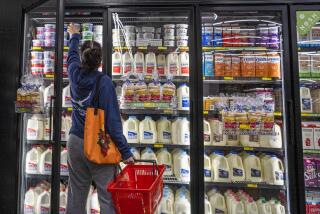Fuel, Food Costs Push ’96 Inflation to 6-Year High
- Share via
WASHINGTON — Consumer price inflation, fueled by a big jump in energy prices and a lesser surge in food costs, rose to 3.3% last year, the highest rate in six years, the Labor Department reported Tuesday.
Outside of food and energy, inflation moderated in every other major part of the consumer price index. That so-called core rate rose 2.6%, matching the figure in 1994 but otherwise the lowest annual rate since 1965.
That meant consumers last year saw modest price increases overall for many items--for example, medical care costs rose only 3%. However, households also paid sharply more for some items they buy every few days, such as gasoline and dairy products.
The average national price for all grades of a gallon of gasoline rose to $1.318 last month from $1.16 in December 1995. Over the same period, prices of milk, cheese and other dairy items were up 10.1%.
Meanwhile, in a separate report, the Commerce Department said retail sales rose 0.6% last month to $208.2 billion, a level that was 4.5% higher last year than in December 1995. Analysts said the figures indicate that the Christmas selling season turned out to be better than in the previous year but still somewhat disappointing to retailers.
Financial markets reacted favorably to the two reports, with investors and traders focusing primarily on the fact that while the CPI rose 0.3% in December, the rise was only 0.1% excluding food and energy items. That eased some concerns that stronger economic growth at the end of the year might ignite inflation, causing the Federal Reserve Board to raise short-term interest rates.
The yield on the bellwether 30-year U.S. Treasury bond fell to 6.76% from 6.85%. With interest rates falling, the Dow Jones average of 30 industrial stocks rose 53.11 points to close at 6,762.29.
In some ways, last year was a mirror image of 1995 on the price front, when a dip in energy prices and a very small increase in food prices had helped hold the overall rise in the CPI to a mere 2.5%.
Now, for 1997, many forecasters are looking for yet another reversal of the impact of volatile food and energy price changes on the inflation rate. They expect some decline in energy prices and a smaller increase in food prices.
As a result, many economists predict that inflation will drop below 3% again in 1997.
“The best bet is that over the course of the year, oil prices will average a little less than last year,” said economist L. Douglas Lee of HSBC Washington Analysis. Some energy experts expect a larger decline this year, which could drive the overall inflation rate down close to the level it was in 1995.
However, many investors, analysts and government policymakers such as those at the Fed focus far more on the core inflation rate--the more than three-quarters of the CPI that covers neither food nor energy prices. It’s not that they don’t care when the price of gasoline soars; rather, they can be pretty confident that it will come back down again.
Only if a big rise in food and energy prices appears likely to become embedded in the nation’s underlying inflation picture are the policymakers likely to become seriously concerned.
Chairman Alan Greenspan and other Fed officials have been watching what is happening to wages more than prices because they are concerned that at some point the nation’s very tight labor markets may cause labor costs to begin to rise more rapidly and cause the core inflation rate to rise.
If that happened, or appeared to be about to happen, the Fed would probably respond by raising short-term interest rates to keep core inflation in check, analysts said.
(BEGIN TEXT OF INFOBOX / INFOGRAPHIC)
Inflation, 1985-1996
Annual percentage change in consumer prices.
Source: Labor Department
(BEGIN TEXT OF INFOBOX / INFOGRAPHIC)
Monthly CPI
Percentage change, month to month, seasonally adjusted.
Source: Labor Department
More to Read
Inside the business of entertainment
The Wide Shot brings you news, analysis and insights on everything from streaming wars to production — and what it all means for the future.
You may occasionally receive promotional content from the Los Angeles Times.









